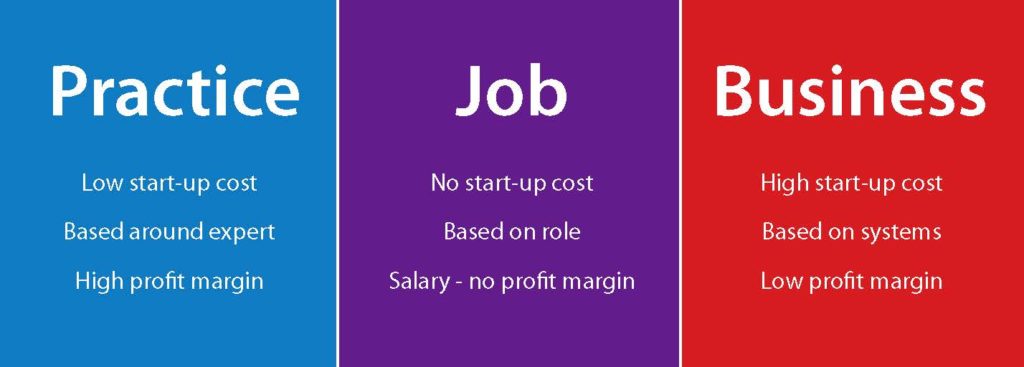Lots of people love the corporate world. The cut and thrust, the resources, the teams. The social aspect of getting to work and play with a bunch of colleagues. The scale of the projects, and what can get accomplished.
For others, not so much.
The other end of the spectrum is what Dilbert author Scott Adams would call “a wage slave”.
I speak to lots of people who dream of going out on their own, but aren’t sure what’s involved or if they have what it takes.
This article outlines what’s involved in being successful on your own, selling your expertise and what I believe are the key skills you’ll need.
The third way to earn a living
There are three ways to earn a living. The two we all hear about are to have a job or run a business.
Ideally in a business, you create systems that other people follow, eventually remove yourself and sell for a lotto-like figure. This is what MindShift.money co-founders Dr. Tony and Makaylah call a Profit-Legacy Business Model.
Alternatively, a job is working in someone else’s business or organization.
The third option is to run a practice. A practice is based on the expertise of the principal. If we use brain surgery as an example, the practice is based on the expertise of the brain surgeon.
While there are other people in the practice supporting the surgeon, she is the one who does all the delivery (in this case, the brain surgery). If she is sick, the receptionist can’t fill in for her. Without the brain surgeon, the practice isn’t worth anything.
This is what Dr. Tony and Makaylah call a Profit Business Model. I refer to it as a practice.
Here are some of the distinctions between the three options:

The practice of a thought leader is based on the subject matter expertise or the ideas of the principal. The expert is typically a consultant, speaker, author, trainer, mentor, facilitator or coach (or ideally a combination of these).
Practices—as opposed to businesses—generally have low start-up costs. For example, many infopreneurs start their practice from home, keeping their overhead down. And practices continue to be funded from the cash-flow created in the practice.
Businesses, on the other hand, have an initial investment focus and even if you build one by boot strapping (that is, by keeping initial costs as low as possible) often at some point they require fundraising or more significant capital investment to get to the next level.
What is a successful practice?
In my view, a successful thought leader’s practice revolves around revenue, lifestyle and legacy. In a nutshell, this means getting well-paid to do work you love, with people you like, while making a difference in the world.
From a financial perspective, this means turning over $500k to $1.5M a year, working 50–200 days, with one or two support staff.
In terms of lifestyle, success is doing work you love, with people you like, the way you want. Given this is about exertion income, to maintain a successful practice for a decade or more is a labour of love.
And finally, a successful practice is one that provides you with the vehicle to make the difference you were born to make. You get to make the contribution that you choose and leave a legacy you’re proud of.
Be a Thought Leader
It is possible to run a practice based on other people’s ideas. You can consult or train or coach using other people’s intellectual property. You can become accredited in Myers-Briggs or Getting Things Done or Life Styles Inventory or any of the thousands of other methodologies out there.
But making the revenue I’m talking about without being a thought leader in your field is much harder.
What do I mean by being a thought leader?
Being a thought leader means extending the thinking in your field, and eventually being positioned as the go-to-person in your domain. The litmus test for this is the answer to the question, “Do you have a book in you?” If writing a book is on your bucket list, then this might be a sign that running a thought leaders practice is for you.
Do I have what it takes?
Getting well paid to do work I love with people I like while making a difference in the world sounds great. But what does it take to be successful at this game?
There are three things a thought leader has to do in a thought leaders practice: think, sell and deliver.
Think – you need to have original ideas and be able to give advice based on those. To be able to bring your own perspective, wisdom and experience to share in a way that can solve problems in the world.
Sell – lots of people would love to just think and deliver, and have someone else bring them the clients. Unfortunately, it doesn’t work like that. You also need to be able to have a conversation with a prospect that ends with them buying.
Deliver – to run a thought leaders practice you need to be able to speak and write. You’ll also make money from coaching, training, facilitating or mentoring, but speaking and writing is the threshold. If the thought of speaking in front of groups terrifies you, and you haven’t written anything since your last college essay, a thought leaders practice probably isn’t for you.
What’s important to realize, should you decide to take the leap and play the practice game, is that you’re pursuing a path few others are treading. The vast majority of today’s workforce is either building a business or working in one, and as a result, their perspective on things is heavily skewed by that model.
If you choose to pursue a thought leadership practice, you need to be aware that you will receive a whole lot of well-meaning bad advice from people unfamiliar with that game. Your friends and colleagues with MBAs and job titles with “manager” in them will be horrified at the thought of your business being simply Your Name.
They will positively balk at the thought of trading your money for time. They’ll be telling you to “productize your knowledge” and other such advice that would be great… if you were running a business.
Thought leadership is something of a game for mavericks, and to succeed, you need to be willing to spend a bit of time sailing into the wind. It’s not always easy, but the rewards are spectacular—both financially and personally.
Note from MindShift.money Co-Founder Makaylah Rogers:
As a world-leading expert on running a commercially successful thought leader’s practice, Peter Cook has (with co-authors Matt Church and Scott Stein) written a book on this topic titled The Thought Leaders Practice. If you’d like to learn the fundamentals of what makes a commercially successful practice tick, I highly encourage you to read Peter’s book.
And, if you order the book here using the coupon code “MINDSHIFT” you’ll receive your copy of The Thought Leaders Practice at no charge–you only pay shipping! This is an exclusive offer we’ve negotiated just for our MindShift.money members, with gratitude to Peter Cook and his team at Thought Leaders.
This is a sponsored post. The views and opinions expressed are those of the guest author and do not necessarily reflect the views and opinions of MindShift.money.
image Credit: Flynt/Bigstock.com

Hi Makaylah where do I get a copy of Peter’s book? Thanks
Hey Susan, the link is at the bottom of the article within the section that is titled “Note from MindShift.money Co-Founder Makaylah Rogers”. Let me know if you can’t find it 🙂